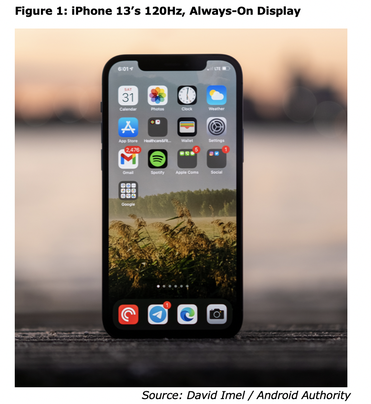Vertical Divider
iPhone 13 to Come with 120 HZ Refresh, Always-on Display and Smaller Notch
The iPhone 13 is expected to be a sizeable upgrade that tackles a few shortcomings and might just put it ahead of the Android competition in some areas, or at least catch-up. While iPhones are fast and responsive, the 12 has 60Hz screen refresh rates while their Android counterparts have moved to 90Hz, 120Hz, and beyond. They haven’t had always-on displays, either. The iPhone 13 is expected to have at 120 Hz and the 2 Pro models will have LTPO panels from Samsung that lessen the impact of VRR and also could support an always on display.
The iPhone 13 is expected to be a sizeable upgrade that tackles a few shortcomings and might just put it ahead of the Android competition in some areas, or at least catch-up. While iPhones are fast and responsive, the 12 has 60Hz screen refresh rates while their Android counterparts have moved to 90Hz, 120Hz, and beyond. They haven’t had always-on displays, either. The iPhone 13 is expected to have at 120 Hz and the 2 Pro models will have LTPO panels from Samsung that lessen the impact of VRR and also could support an always on display.
|
Analyst Ming-Chi Kuo, leaker Max Weinbach, and others have cited sources claiming the iPhone 13 Pro models will include 120Hz displays based on the battery-efficient LTPO (low-temperature polycrystalline oxide) technology found in phones like the Galaxy Note 20 Ultra. Like with some Android devices, the always-on iPhone 13 display would show the clock, battery, and notifications without having to wake the device. The iPhone 13 isn’t expected to involve a radical external redesign. Kuo and others still believe there will be four models, including a 5.4-inch iPhone 13 Mini, a 6.1-inch standard model, a 6.1-inch Pro version, and a 6.7-inch Pro Max. They might be slightly thicker and heavier than the iPhone 12, possibly due to larger batteries and cameras. However, the flat, machined look of the iPhone 12 series would remain intact. |
However, there may be one conspicuous and arguably welcome change: a smaller notch. MacOtakara, iRepair, and other sources claim Apple is optimizing components to reduce the footprint on the front of the phone. It would move the speaker up to the edge while shrinking the area needed for the front cameras and sensors. There would still be a visible notch (no punch-hole or under-display camera here), but it would free up more screen real estate and give the iPhone 13 a more modern look.
The design might also be notable for what it leaves intact. Apple will keep the Lightning port and otherwise pass on the portless version some had anticipated, given wireless charging is expensive and relatively slow.
The design might also be notable for what it leaves intact. Apple will keep the Lightning port and otherwise pass on the portless version some had anticipated, given wireless charging is expensive and relatively slow.
|
The iPhone 12 series’ camera upgrades weren’t particularly democratic as the Pro was required for a telephoto lens and LiDAR, and you needed to buy the 12 Pro Max to get both the best sensors and most advanced stabilization. The iPhone 13 Pro models will receive improved ultra-wide cameras and might get an automatic astrophotography mode. Devoted photographers would still have to buy the Pro Max for the best quality (the main lens would have a brighter f/1.5 aperture), but better image quality should be a common theme across the entire iPhone 13 range.
Kuo doesn’t expect 8K video recording and the requisite higher-resolution sensor to reach the iPhone 13, though. That might have to wait until 2022. Apple’s not exactly in a rush when 8K screens and content are still rare, but this will be something rivals like Samsung can crow about in the future. Apple should introduce an A15 chip that delivers speed and battery life improvements. The upgrades might not be limited to raw computing power, either. Apple currently uses the Qualcomm Snapdragon X55 modem in the iPhone 12 line, and the iPhone 13 range is likely to use this year’s Snapdragon X60. Barclays researchers also predicted support for Wi-Fi 6E, which brings Wi-Fi 6’s technology to the faster and lower-lag 6GHz band. Murmurs at Bloomberg and the Wall Street Journal have suggested Apple is testing an under-display fingerprint reader that would complement Face ID on the iPhone 13. The recent iOS 14.5 update let’s Face ID work with a mask for an Apple Watch. OnePlus Nord CE leaked specs suggests it’ll compete with Samsung’s Galaxy A52. |
|
Contact Us
|
Barry Young
|



